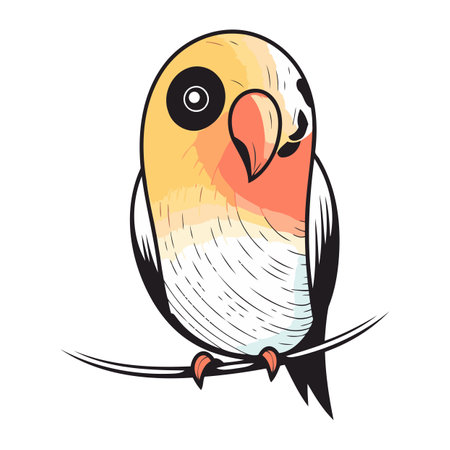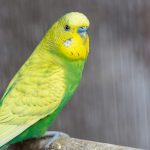1. Choosing the Right Parakeet
Bringing a parakeet into your home is an exciting decision, but choosing the right one requires careful consideration. From selecting a healthy bird to understanding different breeds, here’s what you need to know to find the perfect feathered friend for your lifestyle.
Picking a Healthy Parakeet
A healthy parakeet is active, alert, and social. When visiting a pet store or breeder, observe the bird’s behavior and physical condition. Here are some key signs of a healthy parakeet:
| Health Indicator | What to Look For |
|---|---|
| Eyes | Bright, clear, and free from discharge |
| Feathers | Smooth, well-groomed, and vibrant in color |
| Beak and Feet | No cracks, sores, or unusual growths |
| Breathing | No wheezing or clicking sounds |
| Activity Level | Lively, playful, and responsive to surroundings |
Understanding Different Breeds of Parakeets
The most common type of parakeet in the U.S. is the budgerigar (or “budgie”), but there are several other varieties. Here are some popular parakeet breeds:
| Breed | Description | Lifespan |
|---|---|---|
| Budgerigar (Budgie) | The most common pet parakeet; small, social, and easy to train. | 5-10 years |
| Bourke’s Parakeet | A quieter breed with soft pink and blue feathers; more independent. | 7-15 years |
| Moustached Parakeet | Larger than budgies; known for their distinct mustache-like markings. | 20-25 years |
| Indian Ringneck Parakeet | A highly intelligent breed that can learn to talk. | 25-30 years |
| Linnie (Lineolated Parakeet) | A calmer breed that enjoys climbing rather than flying. | 10-15 years |
Selecting the Best Fit for Your Home and Lifestyle
Your choice of parakeet should match your household environment and personal schedule. Consider these factors before making a decision:
- Noisy vs. Quiet: If you prefer a quieter bird, Bourke’s parakeets or Linnies may be a better choice than the more vocal Indian Ringneck.
- Taming & Training: Budgies are great for beginners due to their friendly nature, while Indian Ringnecks require more patience.
- Lifespan Commitment: Some breeds live much longer than others—make sure youre ready for a long-term commitment!
- Cage Space: Larger species like Moustached Parakeets need bigger enclosures and more room to fly.
- Your Schedule: Social birds need daily interaction—if youre busy, consider getting a pair so they can keep each other company.
The Best Places to Get Your Parakeet
You can find parakeets at pet stores, breeders, or rescue organizations. Each option has its pros and cons:
| Source | Pros | Cons |
|---|---|---|
| Pet Store | Easily accessible; variety of colors available. | Might not have detailed health or background history. |
| Breeder | You can get hand-raised birds with known backgrounds. | Might be more expensive; requires research to find reputable breeders. |
| An Animal Rescue or Shelter | You provide a home to a bird in need; often lower cost. | The bird may require extra care if it has had past trauma or neglect. |
Your First Steps After Bringing Your Parakeet Home
The transition period is crucial for helping your new bird feel comfortable. Give them time to adjust by keeping their cage in a quiet area and avoiding sudden movements. Speak softly and allow them to observe their new environment before attempting handling or training.
Selecting the right parakeet is an important first step toward creating a happy and healthy bond with your new pet. By choosing wisely based on health, breed characteristics, and lifestyle compatibility, you’ll set yourself up for a rewarding experience as a parakeet owner.
2. Setting Up the Perfect Habitat
Creating a comfortable and safe environment for your parakeet is essential for their well-being. From choosing the right cage to adding perches and toys, here’s everything you need to know to set up the perfect habitat.
Choosing the Right Cage
Your parakeets cage should be spacious enough for them to move around, stretch their wings, and play. A good rule of thumb is to choose a cage that is at least 18 inches wide, 18 inches deep, and 24 inches tall for one bird. If you have multiple parakeets, opt for a larger cage.
| Number of Parakeets | Recommended Cage Size (L x W x H) |
|---|---|
| 1 | 18″ x 18″ x 24″ |
| 2 | 30″ x 18″ x 24″ |
| 3+ | 32″+ x 20″+ x 30″+ |
Perches: Essential for Foot Health
Parakeets spend most of their time standing on perches, so its important to provide a variety of perch types. Avoid using only smooth wooden dowels—natural wood branches, rope perches, and textured perches help keep their feet healthy and prevent sores.
Best Types of Perches:
- Natural Wood Perches: Mimic tree branches and promote foot exercise.
- Rope Perches: Soft and flexible, great for resting.
- Cement or Sand Perches: Help keep nails trimmed but should not be the only type provided.
Toys for Mental Stimulation
Parakeets are intelligent birds that need mental stimulation to stay happy. Provide a variety of toys such as swings, bells, mirrors, and shreddable paper toys. Rotate toys weekly to keep things interesting.
Toy Ideas:
- Bells & Mirrors: Keep parakeets entertained when alone.
- Ladders & Swings: Encourage exercise and movement.
- Shreddable Toys: Satisfy their natural chewing instincts.
The Ideal Cage Location
Where you place your parakeet’s cage matters. Choose a quiet yet social area where they can interact with family members but won’t be overwhelmed by loud noises or sudden disturbances.
Cage Placement Tips:
- Avoid direct sunlight or drafty areas.
- Keep away from kitchens due to fumes from cooking.
- Place the cage at eye level to help your bird feel secure.
- Avoid placing near windows where sudden outdoor activity may startle them.
Maintaining a Clean Environment
A clean cage is crucial for your parakeet’s health. Regular cleaning prevents bacteria buildup and keeps your pet comfortable.
| Cleaning Task | Frequency |
|---|---|
| Change food & water dishes | Daily |
| Wipe down perches & toys | Weekly |
| Replace cage liner/newspaper | Every 2-3 days |
| Deep clean cage (wash with mild soap & water) | Monthly |
A well-set-up habitat will ensure your parakeet stays happy, active, and healthy. With the right cage size, engaging toys, varied perches, and proper placement, your feathered friend will thrive in their home!

3. Proper Nutrition for a Healthy Parakeet
Providing your parakeet with a balanced and nutritious diet is essential for its overall health and longevity. A well-fed parakeet will have bright feathers, high energy levels, and a strong immune system. Below, we’ll cover the key components of a proper parakeet diet.
Essential Foods for Your Parakeet
A healthy diet for a parakeet consists of various food groups, including seed mixes, fresh fruits and vegetables, and nutritional supplements. Offering a variety of foods ensures they receive all the necessary vitamins and minerals.
Seed Mixes vs. Pellets
Many parakeet owners rely on seed mixes as the primary food source, but seeds alone do not provide all the nutrients your bird needs. Pellets are a more balanced option because they contain essential vitamins and minerals.
| Food Type | Benefits | Considerations |
|---|---|---|
| Seed Mixes | Natural and appealing to parakeets | Can be high in fat; lacks some essential nutrients |
| Pellets | Balanced nutrition with added vitamins | Some birds may take time to adjust to eating pellets |
Fresh Fruits and Vegetables
Adding fresh produce to your parakeet’s diet provides important vitamins and hydration. Some great options include:
- Fruits: Apples (seedless), bananas, berries, oranges (in moderation)
- Vegetables: Carrots, spinach, bell peppers, broccoli
Avoid feeding avocados, onions, garlic, or chocolate, as these can be toxic to birds.
Nutritional Supplements
Even with a varied diet, some additional supplements can help keep your parakeet healthy. Consider providing:
- Cuttlebone: A great source of calcium for strong bones.
- Mineral Blocks: Helps prevent nutrient deficiencies.
- Probiotics: Supports digestive health.
Feeding Schedule and Portion Control
Parakeets should always have access to fresh food and water. However, avoid overfeeding seeds as they can lead to obesity. A good approach is to offer pellets daily with small portions of seeds as treats.
Daily Feeding Guide
| Food Type | Recommended Amount |
|---|---|
| Pellets or Seed Mix | 1-2 teaspoons per day |
| Fresh Fruits & Vegetables | A small portion (about one teaspoon) |
| Cuttlebone / Mineral Block | Available at all times |
Water Requirements
Your parakeet needs fresh water daily. Change their water bowl every morning and clean it regularly to prevent bacteria buildup. Avoid giving them sugary drinks or flavored beverages—clean water is best!
Monitoring Your Parakeets Diet
If you notice changes in your parakeet’s eating habits or weight, it could indicate an underlying health issue. Keep an eye on their diet and consult a vet if you notice any unusual behavior.
A well-balanced diet will keep your feathered friend happy and energetic. By providing the right mix of seeds, pellets, fresh produce, and supplements, you’ll ensure they live a long and healthy life!
4. Training and Bonding with Your Parakeet
Building a strong bond with your parakeet takes patience and consistency. Training helps establish trust, teach basic commands, and even encourage them to mimic sounds and words. Here’s how you can effectively train and bond with your feathered friend.
Building Trust with Your Parakeet
Before starting any training, your parakeet needs to feel safe and comfortable in its environment. Follow these steps to gain their trust:
- Spend Time Nearby: Sit close to the cage and talk softly to let them get used to your presence.
- Offer Treats by Hand: Hold millet or small treats near them to encourage interaction.
- Avoid Sudden Movements: Move slowly and gently around your parakeet to prevent startling them.
Teaching Basic Commands
Once your parakeet trusts you, you can start teaching simple commands like stepping onto your finger or returning to their perch. Here’s a step-by-step guide:
| Command | Training Steps |
|---|---|
| “Step Up” | Hold a finger near their chest and gently nudge while saying “Step up.” Reward them when they obey. |
| “Step Down” | Move them to a perch and say “Step down” as they transfer from your hand. |
| “Come Here” | Use treats and call their name to encourage flying towards you. |
Encouraging Mimicry: Teaching Words and Sounds
Parakeets are excellent mimics! With regular practice, they can learn simple words and phrases. Here’s how:
Tips for Teaching Your Parakeet to Talk
- Start with Simple Words: Use short, clear words like “hello” or their name.
- Repeat Often: Say the word multiple times throughout the day in a cheerful tone.
- Create Associations: Pair words with actions, such as saying “treat” before giving food.
- Praise Success: Reward attempts at speech with excitement or treats.
The more time you spend interacting with your parakeet, the more confident and social they will become. Keep sessions fun and rewarding to strengthen your bond!
5. Common Health Issues and Care Tips
Keeping your parakeet healthy is essential for a long and happy life. Understanding common health issues, recognizing signs of illness, and knowing when to seek veterinary care can make all the difference in ensuring your bird’s well-being.
Recognizing Signs of Illness
Parakeets are good at hiding illness, so it’s important to be observant. Here are some key signs that your bird may be sick:
- Fluffed-up feathers for extended periods
- Loss of appetite or difficulty eating
- Lethargy or unusual sleeping patterns
- Changes in droppings (color, consistency, or frequency)
- Labored breathing or wheezing
- Swelling around the eyes or beak
- Unusual aggression or extreme quietness
Common Health Problems in Parakeets
Certain health issues are more common in parakeets than others. Below is a table summarizing some frequent conditions and their symptoms:
| Health Issue | Symptoms | Prevention/Treatment |
|---|---|---|
| Respiratory Infections | Sneezing, nasal discharge, wheezing | Avoid drafts, keep cage clean, consult a vet if symptoms persist |
| Mites and Parasites | Itchy skin, feather loss, scaly legs or beak | Regular cage cleaning, specialized sprays or vet treatment |
| Nutritional Deficiencies | Poor feather condition, weakness, lack of energy | A balanced diet with fresh fruits, vegetables, and high-quality pellets |
| Bumblefoot | Sores on feet, difficulty perching | Provide soft perches, keep cage floor clean, seek vet advice if severe |
| Crop Disorders | Difficulties swallowing, swollen crop area | Avoid feeding too cold or too hot foods; see a vet if persistent |
| Liver Disease (Fatty Liver Syndrome) | Lethargy, overgrown beak, yellowish droppings | Avoid fatty seeds; provide fresh greens and exercise opportunities |
Preventing Health Problems
The best way to keep your parakeet healthy is through prevention. Follow these tips to reduce the risk of illness:
- Maintain a Clean Environment: Clean food bowls daily and disinfect the cage regularly.
- A Balanced Diet: Offer a mix of seeds, pellets, fresh vegetables, and fruits.
- Avoid Stress: Keep your bird’s environment stable and minimize loud noises or sudden changes.
- Regular Exercise: Provide toys and allow supervised out-of-cage time for mental stimulation.
- Avoid Toxic Substances: Keep your parakeet away from smoke, scented candles, and non-stick cookware fumes.
- Adequate Hydration: Ensure fresh water is available at all times.
When to Seek Veterinary Care
If you notice any concerning symptoms that persist for more than 24 hours or if your bird suddenly becomes lethargic and weak, consult an avian veterinarian immediately. Early intervention can prevent serious complications and improve recovery chances.
Your parakeet depends on you for its health and happiness. By staying informed and proactive in its care, you can ensure a long and fulfilling companionship with your feathered friend.


